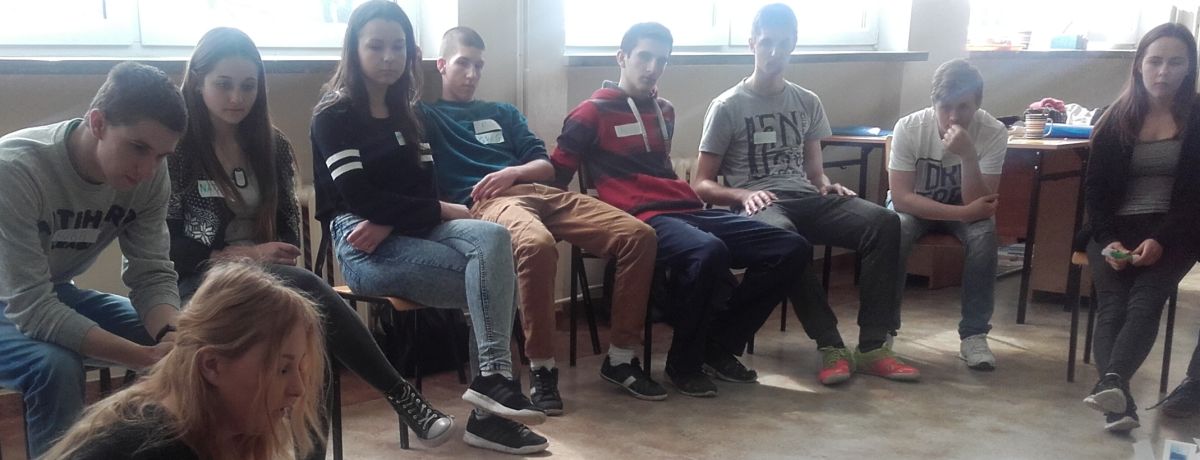| 2016 |
Dubienka
Volhynian Infantry Division High School


| 2016 |
Dubienka, a former royal free city, and nowadays a village in the Chełm region, situated on the banks of a charmingly called river, Wełnianka (“Wooly Creek”), used to be famous for its trade and boatbuilding. In the 17th century, Dubienka was burned down by Tartars, in the 19th century trade started to decline and today the village has become mainly a tourist destination. Not so far away flows the river Bug with its pikes, pike-perches and tenches. There also are two lakes with a watering-place, a bay and a lot of greenery.
Apart from Catholics, also members of the Orthodox Church and Jews used to live in Dubienka. The latter appeared in Dubienka in late 16th century, presumably in the year 1589. They built a synagogue and established their own cemetery. They were merchants, they produced alcoholic beverages, they sold ships. They had their shops and built slaughterhouses. In the year 1768, 2318 Jews lived in Dubienka, comprising 76% of the village’s population.
In late spring 2016, high school students from Dubienka were confronted with previously unknown history. Between the two workshops conducted by the School of Dialogue educators, Małgorzata Nowicka and Barbara Rostek, the students walked around looking for people who could tell them something bout Jews from Dubienka: local inhabitants, elderly people who still remembered the time before the war.
In the interwar period, apart from the synagogue and cemetery, Jews had six cheders, three prayer houses and one mikveh. In the 1920s and 1930s, social and political life flourished: organizations active in the town included Bund, Aguda and Zionist parties, as well as the “Jawne” (“overt”, “not secret”) Cultural and Educational Association, the aim of which was to provide education to adults. In the 1930s also Bais Yaakov, a school for girls, was founded. At the same time, more and more Jews were leaving Dubienka and emigrating abroad. Out of those who stayed, 54 were murdered at the very beginning of the occupation by Germans, who also destroyed the synagogue and mikveh. In 1942, they established the ghetto to which they moved ca. 3 thousand people, including 100 Jews from Cracow and 600 from Mielec.
On June 2, 1942, 2670 Jews were taken to Sobibór and ca. 250 were murdered on the Jewish cemetery. In the ghetto they left only craftsmen and a few women, who were executed during the liquidation of the ghetto, on October 19 that same year. It is not known whether anyone returned to Dubienka later.
At the beginning of the June walking tour organized by the high school students, one of the teenagers who participated in the School of Dialogue project explained to the guests where the cheders were located and what their function was. At the pharmacy building, Kamil and Grzegorz told the story of Mr. Ziębiński, who provided shelter to several Jews in his pharmacy. When they reached the house previously owned by Mr and Mrs. Grabowski, Paulina talked about the Jewish woman who had sought refuge in that house. By the house which is now painted yellow and which once belonged to Icek Goldberg, Laura and Konrad recounted his story – Icek Goldberg sold wood and was the richest citizen of Dubienka. The house, built in 1926, was intended as his daughter’s dowry. During the war it housed the municipal office and after the war it was given to its current owner.
On the market square Kacper and Norbert said what it looked like before that war, when Jews used to live there. What the buildings were like, whether they had any characteristic details and how close they stood to each other.
In the Dubienka Hall of Memory, Bartek showed objects connected with the professions of Jews who used to live there before the war. In the spot where the synagogue used to stand and now there is a bus stop, Krystian explained what this prayer house meant for the Jews.
At the very end of the tour, on the Jewish cemetery, Krzysztof told the story of the tzadik who is buried there, about the graveyard itself and about its history. Today, at the bifurcation of Piaski street there are no matzevot left, and the area of the cemetery was partially built over. Some time ago, on the presumed place of tzadik Uri Fajwel’s grave, a commemorative tombstone has been erected. In July 2006, construction works on the fence of the part of the graveyard which was not built upon were completed.
After the tour the guests were treated to snacks in the form of challah bread, apples in honey and dates.

School:
27. Volhynian Infantry Division High School
Students:
1st and 2nd year students
Teacher:
Dorota Ulanicka
Educators:
Małgorzata Nowicka, Barbara Rostek
School of Dialogue program in Dubienka was made possible by the support from MICHELLE ORES.
In appreciation to the Conference on Jewish Material Claims Against Germany (Claims Conference) for supporting this educational program. Through recovering the assets of the victims of the Holocaust, the Claims Conference enables organizations around the world to provide education about the Shoah and to preserve the memory of those who perished.

In appreciation to Friends of the Forum for supporting the School of Dialogue educational program.
